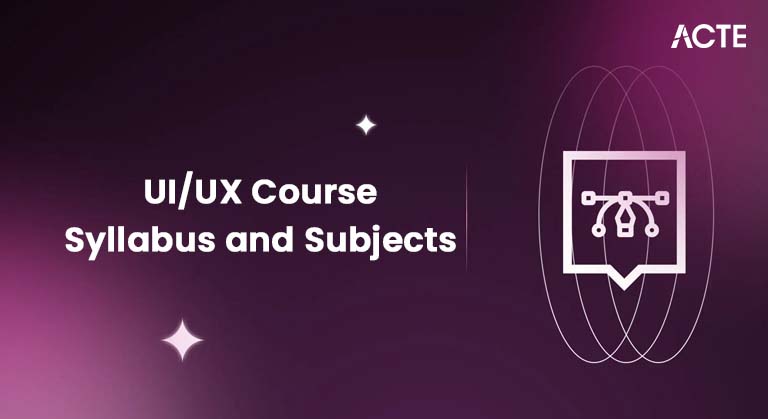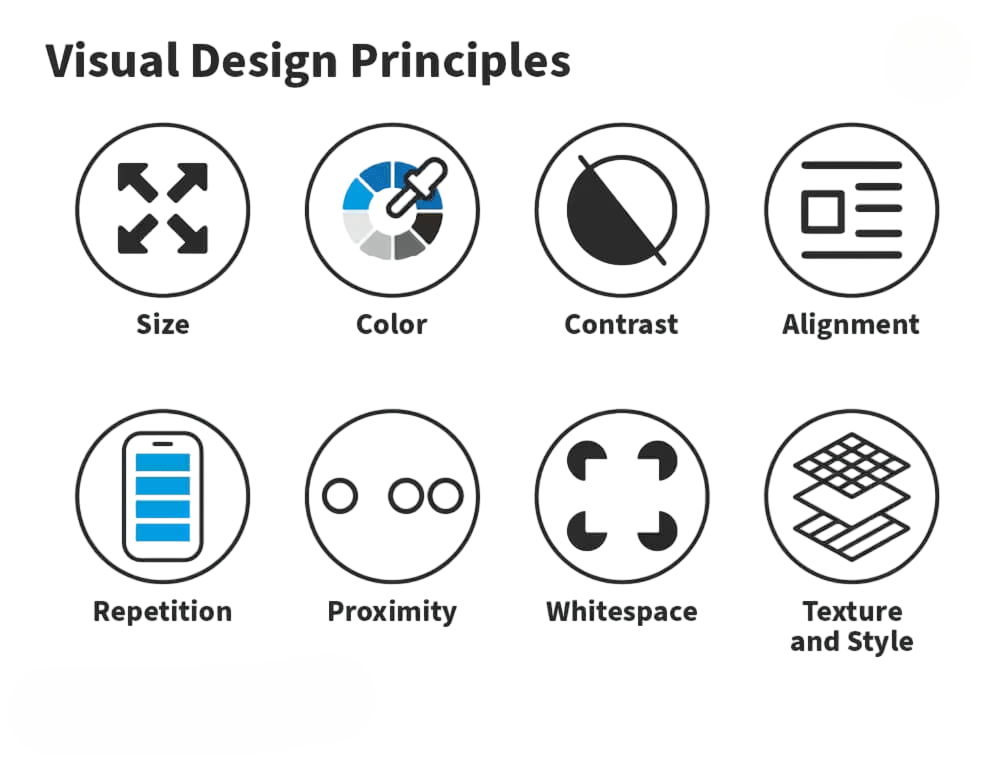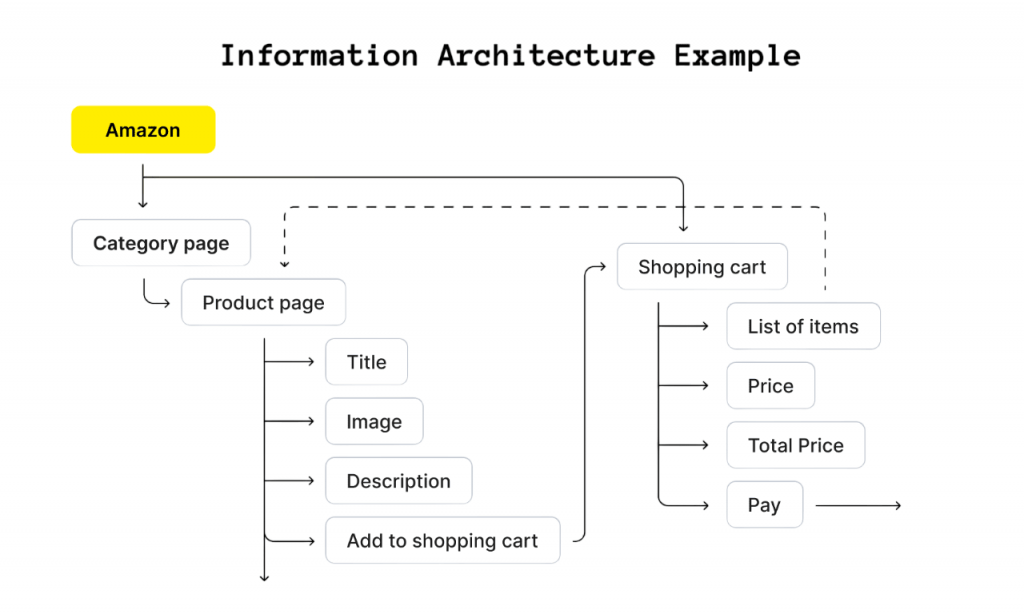
- Overview of UI/UX Curriculum
- Visual Design Principles
- Wireframing and Prototyping
- User Research and Personas
- Information Architecture
- Design Tools: Figma, XD, Sketch
- Usability Testing and Feedback
- Portfolio Development
- Group Projects and Internships
- Conclusion
Overview of UI/UX Curriculum
The UI/UX Course Syllabus and Subjects is designed to equip learners with comprehensive skills to design engaging, usable, and accessible digital experiences. It balances theory and practical application, combining creative, analytical, and technical aspects of design making UI/UX Training indispensable for mastering the full spectrum of design thinking, prototyping, and user-centered development. A well-structured curriculum covers everything from foundational visual design principles to advanced user research and usability testing, using industry-standard tools and real-world projects. This prepares students for careers as UI/UX designer syllabus Information Architecture, interaction designers, Wireframing or product designers.Below is an in-depth look at the essential components of a typical UI/UX curriculum.
Ready to Get Certified in UI/UX Design? Explore the Program Now UI/UX Design Online Training Offered By ACTE Right Now!
Visual Design Principles
Visual design is the foundation of the UI/UX curriculum. It carefully examines how digital products communicate through their appearance and function. The syllabus covers essential design principles that turn basic screens into engaging visual experiences. Students master color theory by looking at both the psychological and technical aspects of color models. This helps them create pleasing and accessible color schemes that evoke specific feelings. Typography lessons focus on choosing fonts, establishing hierarchy, and using spacing effectively. Students learn how typography can greatly affect user understanding and engagement. Layout and composition techniques are taught using grid systems, balance, and careful alignment. This empowers students to arrange content in a clear and attractive way.

By studying visual hierarchy, learners gain the skills to prioritize elements on the interface. This guides users’ attention naturally and improves interaction flow. The curriculum also covers iconography and image selection. Students see how visual components can enhance content and increase user understanding. Importantly, students learn to keep design consistent and to follow brand guidelines. This ensures a cohesive and professional user experience. Through this well-rounded approach, the course fosters a strong sense of aesthetics, preparing designers to create visually appealing interfaces that effectively lead users through digital environments.
Wireframing and Prototyping
Wireframing and prototyping are critical stages where ideas move from concept to tangible form.
- Wireframing: Creating low-fidelity, skeletal representations of a user interface. Focuses on layout, content placement, and navigation flow without detailed visual design principles. Helps validate structure and user pathways early on.
- Prototyping: Building interactive, higher-fidelity models that simulate user interaction. Allows usability testing, stakeholder demos, and feedback collection. Can be static click-throughs or dynamic prototypes with animations and conditional logic.
- Tools and Techniques: Curriculum covers tools like Figma, Adobe XD, Sketch, and InVision to build wireframes and prototypes efficiently.
- Learning Outcomes: Students learn to translate ideas into practical designs, iterate quickly, and communicate concepts clearly.
- Qualitative: Interviews, focus groups, ethnographic studies.
- Quantitative: Surveys, analytics, heatmaps.
- User Personas: Fictional but data-driven profiles representing key user segments. Help designers empathize and keep users at the center throughout the design process.
- Journey Mapping: Visualizing a user’s end-to-end interaction with a product to identify friction points and opportunities.
- Usability Goals: Defining what success looks like from the user’s perspective.
- Learning Outcomes: Students acquire skills in conducting research, analyzing data, and synthesizing insights into actionable personas and requirements.
- Moderated vs Unmoderated: Facilitated sessions versus remote automated tests.
- Qualitative: Observing behavior and gathering subjective feedback.
- Quantitative: Measuring task success rates, time on task, error frequency.
- Think-aloud protocol
- A/B testing
- Surveys and questionnaires
- Iteration: Using test results to refine designs and improve user experience continually.
- Learning Outcomes: Students understand how to plan, conduct, and analyze usability tests to inform data-driven design decisions.
- Guidelines: WCAG (Web Content Accessibility Guidelines) provide detailed standards for color contrast, keyboard navigation, screen reader compatibility, etc.
- Designing for keyboard-only navigation
- Providing alt text for images
- Using semantic HTML
- Avoiding color reliance alone to convey information
- Portfolio Elements: Case studies describing problem statements, research, design process, challenges, and outcomes. Visual assets like wireframes, prototypes, and final designs. Demonstrations of usability testing and iterations.
- Presentation: Clear storytelling focusing on the designer’s role and impact. Responsive portfolio websites optimized for various devices.
- Continuous Improvement: Encouraged to update portfolios with new projects and reflect on feedback.
- Learning Outcomes: Students learn to create compelling portfolios that highlight their problem-solving abilities and design expertise.
- Group Projects: Simulate UI/UX course syllabus and subjects cross-functional team environments with roles such as UX researcher, UI designer, and developer. Emphasize communication, conflict resolution, and agile methodologies.
- Internships: Provide exposure to live projects, client interactions, and industry workflows. Help build professional networks and resumes.
- Learning Outcomes: Students gain practical insights, soft skills, and industry exposure vital for career readiness.
To Explore UI/UX in Depth, Check Out Our Comprehensive UI/UX Online Training To Gain Insights From Our Experts!
User Research and Personas
User research grounds design in real user needs, motivations, and pain points.
Research Methods:
Information Architecture
Information Architecture (IA) is an important field that organizes and structures digital content to create user-friendly experiences. By using key ideas like hierarchical organization, effective navigation design, and clear labeling, IA professionals build smooth paths that help users navigate complex information.

Techniques such as card sorting and site mapping help practitioners understand and visualize content structures from the user’s point of view. The main goal of Information Architecture is to create logical, scalable content frameworks that make it easy to find information and help users complete their tasks with little effort. Through careful design and thoughtful categorization, IA changes confusing digital environments into clear, navigable spaces that improve usability and user satisfaction.
Looking to UI/UX Training? Discover the UI/UX Design Expert Masters Program Training Course Available at ACTE Now!
Design Tools: Figma, Adobe XD, Sketch
Information Architecture (IA) is an important field that organizes and structures digital content to create intuitive user experiences. By using key ideas like hierarchical organization, effective navigation design, and clear labeling, IA professionals build smooth pathways that help users navigate complex information making UI/UX Training vital for mastering the principles of information architecture and designing interfaces that support clarity, usability, and intuitive flow. Techniques such as card sorting and site mapping help practitioners understand and visualize content structures from the user’s viewpoint. The main goal of Information Architecture is to create logical, scalable content frameworks that make it easy for users to find information and complete their tasks with little effort. Through careful design and smart categorization, IA turns complicated digital spaces into clear, navigable areas that improve usability and user satisfaction.
Usability Testing and Feedback
Usability testing validates designs by observing real users interacting with prototypes or live products.
Testing Types:
Methods:
Accessibility ensures that digital products are usable by everyone, including people with disabilities.
Techniques:
Legal and Ethical Importance is Accessibility compliance is legally required in many countries and reflects social responsibility. Learning Outcomes is students develop the mindset and skills to build inclusive products that broaden audience reach and improve overall usability.
Preparing for UI/UX Design Job Interviews? Have a Look at Our Blog on UI/UX Design Interview Questions and Answers To Ace Your Interview!
Portfolio Development
A strong portfolio is essential for UI/UX designers to showcase their skills and land jobs or freelance clients.
Group Projects and Internships
Collaborative projects and internships provide real-world experience and teamwork skills.
Conclusion
UI/UX Course Syllabus and Subjects A comprehensive UI/UX designer syllabus offers an integrated learning path from fundamental design concepts to advanced user-centered methodologies. It combines theory, hands-on tool training, real-world projects, and professional skills development to prepare learners for the competitive and evolving UI/UX designer syllabus landscape making UI/UX Training essential for mastering Information Architecture and building user-centric digital experiences that meet modern design standards. Aspiring designers benefit immensely from structured programs that include visual design principles, user research, prototyping, usability testing, accessibility, and portfolio development. The inclusion of group projects and internships further bridges the gap between classroom learning and professional practice.With the UI/UX design field continuously expanding, Wireframing a solid curriculum enables students to build adaptable skills and thrive as creative problem solvers shaping the digital experiences of tomorrow.




